Lazurite
A valid IMA mineral species
This page kindly sponsored by Mary Keesling
About Lazurite
Formula:
Na7Ca(Al6Si6O24)(SO4)(S3) · H2O
Often there is minor K substituting for Na.
The IMA used to take the ideal formula with S as the dominant anion and not sulfate, from Hassan et al. (1985), but even that reference indicates that sulfate is dominant, making lazurite either a sulfide rich variety of Hauyne or just a theoretical endmember of a series with hauyne. To deal with this problem the IMA, based on the work of Sapozhnikov et al (2021), now only requires just more than a quarter of the cages to contain the (S3)-1 blue colorant. While the formula was formerly given as Na6Ca2(Al6Si6O24)(SO4,S,S2,S3,Cl,OH)2 has now been redefined to Na7Ca(Al6Si6O24)(SO4)(S3)1- · H2O
The IMA used to take the ideal formula with S as the dominant anion and not sulfate, from Hassan et al. (1985), but even that reference indicates that sulfate is dominant, making lazurite either a sulfide rich variety of Hauyne or just a theoretical endmember of a series with hauyne. To deal with this problem the IMA, based on the work of Sapozhnikov et al (2021), now only requires just more than a quarter of the cages to contain the (S3)-1 blue colorant. While the formula was formerly given as Na6Ca2(Al6Si6O24)(SO4,S,S2,S3,Cl,OH)2 has now been redefined to Na7Ca(Al6Si6O24)(SO4)(S3)1- · H2O
Colour:
Ultramarine, midnight blue, bluish green, green
Lustre:
Resinous
Hardness:
5 - 5½
Specific Gravity:
2.38 - 2.45
Crystal System:
Isometric
Member of:
Name:
From the Persian "Lazhward" for "blue." Also for its dark blue color resemblance to "azurite." Both Lazurite and azurite derive from "Lazhward".
Dana (System of Mineralogy, 1868) considered lapis-lazuli to be the dark blue mineral in the lazulite-calcite rock of the same name, but these were renamed lazurite in 1891 Brögger W C, Bäckström H 1891.
Dana (System of Mineralogy, 1868) considered lapis-lazuli to be the dark blue mineral in the lazulite-calcite rock of the same name, but these were renamed lazurite in 1891 Brögger W C, Bäckström H 1891.
Lazurite is the blue component of the 'gemstone' (or, more usually, decorative rock) Lapis Lazuli, which is a lazurite-calcite-pyrite rock that has been mined as a gem material for some 9,000 years. Dana (System of Mineralogy, 1868) considered lapis-lazuli to be the dark blue crystals in this rock, but these were renamed lazurite in 1891 Brögger W C, Bäckström H 1891.
Before the 2021 redefinition, all* lazurites were only sulfide-rich varieties of Hauyne and not a separate species.Moore & Woodside, 2014 The former definition requires more than half the cages to contain sulfide, but the new definition only requires a quarter of the cages filled with (S3)-1.
* With one exception: Rastsvetaeva et al. (2002) give a formula Na6.34Ca1.66(Al6Si6O24)((SO4)0.88S1.26) for a sample from the Malo-Bystrinskoe deposit.
Lazurite is an ultramarine to midnight-blue, opaque, and non-fluorescent mineral with a bright blue streak. The lower limit of polysulphide (primarily S3−1), which is responsible for the blue colour of lazurite, is ~0.4 at%; however, in some cases, there is no explicit correlation between blue colour and polysulphide content (Tauson et al., 2012).
Some blue-green and green "lazurites" (hauynes) have a small unit-cell edge. Since S is smaller than SO4, these were mistakenly thought to be probably dominant in sulfur. These "lazurites" are translucent and fluorescent under long-wave UV and have a white streak just as hauyne has. The name lazurite should not be applied to these small-cell green hauynes.
Lazurite and hauyne are members of the Sodalite Group, in the feldspathoid family. The two sodalite cages in lazurite are mostly made from either [Na3Ca·SO4]+3. or [Na4(S3)–]+3 clusters. If there's enough (S3)-1 to just more than fill a quarter of the cages, then we have Lazurite with the above formula. With just over three quarters of the cages containing sulfate, we have hauyne. Notice that (S3)-1 quenches fluorescence, so if it fluoresces it is hauyne, but if not, it may not have enough (S3)-1 for lazurite and just be a nonfluorescent hauyne. It would be much simpler to define Lazurite as a nonfluorescent hauyne. The sodalite variety Hackmanite is defined as a reversible photochromic sulfide containing variety of sodalite.
It is difficult to determine the oxidation state of sulfur in a sodalite cage. S, S2, S3, S4, SO3, and SO4 have been suggested.Tauson et al. 2003 ,"Fleet et al., 2005. By XPS and XAS spectroscopy, Tauson et al. (2012) detected sulfate and polysulphides as main constituents in the structural cages of lazurites; additionally, sulfite, thiosulphate, monosulphide, and elemental sulfur were found.
As such, most of the pictures showing "lazurite" do not show true lazurite.
Finally redefined (IMA proposal 20 H, 2021) as bearing both the sulfate(VI) and trisulfide as essential anions. There are commensurate and incommensurate modulations in the structure. The cubic sub-cell is equal to 9.087(3) Å. The neotype sample is slightly birefringent.
A possible triclinic dimorph (?) is known: UM1976-26-SiOSO:AlCaClHNa. Compare this with closely related, orthorhombic Vladimirivanovite and the polytype Lazurite-O. Lazurite-C is a monoclinic polytype.
 Visit gemdat.org for gemological information about Lazurite.
Visit gemdat.org for gemological information about Lazurite.
Before the 2021 redefinition, all* lazurites were only sulfide-rich varieties of Hauyne and not a separate species.Moore & Woodside, 2014 The former definition requires more than half the cages to contain sulfide, but the new definition only requires a quarter of the cages filled with (S3)-1.
* With one exception: Rastsvetaeva et al. (2002) give a formula Na6.34Ca1.66(Al6Si6O24)((SO4)0.88S1.26) for a sample from the Malo-Bystrinskoe deposit.
Lazurite is an ultramarine to midnight-blue, opaque, and non-fluorescent mineral with a bright blue streak. The lower limit of polysulphide (primarily S3−1), which is responsible for the blue colour of lazurite, is ~0.4 at%; however, in some cases, there is no explicit correlation between blue colour and polysulphide content (Tauson et al., 2012).
Some blue-green and green "lazurites" (hauynes) have a small unit-cell edge. Since S is smaller than SO4, these were mistakenly thought to be probably dominant in sulfur. These "lazurites" are translucent and fluorescent under long-wave UV and have a white streak just as hauyne has. The name lazurite should not be applied to these small-cell green hauynes.
Lazurite and hauyne are members of the Sodalite Group, in the feldspathoid family. The two sodalite cages in lazurite are mostly made from either [Na3Ca·SO4]+3. or [Na4(S3)–]+3 clusters. If there's enough (S3)-1 to just more than fill a quarter of the cages, then we have Lazurite with the above formula. With just over three quarters of the cages containing sulfate, we have hauyne. Notice that (S3)-1 quenches fluorescence, so if it fluoresces it is hauyne, but if not, it may not have enough (S3)-1 for lazurite and just be a nonfluorescent hauyne. It would be much simpler to define Lazurite as a nonfluorescent hauyne. The sodalite variety Hackmanite is defined as a reversible photochromic sulfide containing variety of sodalite.
It is difficult to determine the oxidation state of sulfur in a sodalite cage. S, S2, S3, S4, SO3, and SO4 have been suggested.Tauson et al. 2003 ,"Fleet et al., 2005. By XPS and XAS spectroscopy, Tauson et al. (2012) detected sulfate and polysulphides as main constituents in the structural cages of lazurites; additionally, sulfite, thiosulphate, monosulphide, and elemental sulfur were found.
As such, most of the pictures showing "lazurite" do not show true lazurite.
Finally redefined (IMA proposal 20 H, 2021) as bearing both the sulfate(VI) and trisulfide as essential anions. There are commensurate and incommensurate modulations in the structure. The cubic sub-cell is equal to 9.087(3) Å. The neotype sample is slightly birefringent.
A possible triclinic dimorph (?) is known: UM1976-26-SiOSO:AlCaClHNa. Compare this with closely related, orthorhombic Vladimirivanovite and the polytype Lazurite-O. Lazurite-C is a monoclinic polytype.
 Visit gemdat.org for gemological information about Lazurite.
Visit gemdat.org for gemological information about Lazurite.Unique Identifiers
Mindat ID:
2357
Long-form identifier:
mindat:1:1:2357:9
GUID
(UUID V4):
(UUID V4):
e927d6d5-4642-409a-b046-b9dc7c05ea85
IMA Classification of Lazurite
Approved
IMA status notes:
Redefined by the IMA
IMA Formula:
Na7Ca(Al6Si6O24)(SO4)(S3)1- · H2O
Approval history:
Based on Brögger W C, Bäckström H 1891 the name lazurite was grandfathered by the IMA who later gave it Hassan's ideal formula, Na3Ca(Si3Al3)O12S Hassan et al. 1985. The data used by Hassan all came from hauynes with approximately Na6Ca2(Al6Si6O24)(SO4,S,Cl,OH)2 as no sulfide-dominant mineral required by Hassan's formula had been observed.
The situation was similar to sodalite and hackmanite defined as a sulfur dominant sodalite which was never found. In sodalite, Cl is the dominant cage filler and such an ideal hackmanite would have S as the cage filler. Though S readily substitutes for Cl in sodalite, no sulfide-dominant species was ever observed. On that basis hackmanite never was approved, avoiding the approval of a hypothetical mineral. Before the 2021 redefinition, the situation was reversed with lazurite and hauyne. What was commonly called lazurite, all had dominant SO4 and were sulfide-rich hauynes, just as all hackmanites were sulfide-rich sodalites. Now Hackmanite is defined as a reversible photochromic variety of sodalite.
The redefinition of Lazurite as Hauyne with just more than a quarter of its cages containing sulfide is due to acceptance of the proposal 20-H (Newsletter #60). The neotype specimen originates from the Malo-Bystrinskoe azurite deposit, Baikal Lake area, eastern Siberia, Russia, and was published by Sapozhnikov et al (2021).
The situation was similar to sodalite and hackmanite defined as a sulfur dominant sodalite which was never found. In sodalite, Cl is the dominant cage filler and such an ideal hackmanite would have S as the cage filler. Though S readily substitutes for Cl in sodalite, no sulfide-dominant species was ever observed. On that basis hackmanite never was approved, avoiding the approval of a hypothetical mineral. Before the 2021 redefinition, the situation was reversed with lazurite and hauyne. What was commonly called lazurite, all had dominant SO4 and were sulfide-rich hauynes, just as all hackmanites were sulfide-rich sodalites. Now Hackmanite is defined as a reversible photochromic variety of sodalite.
The redefinition of Lazurite as Hauyne with just more than a quarter of its cages containing sulfide is due to acceptance of the proposal 20-H (Newsletter #60). The neotype specimen originates from the Malo-Bystrinskoe azurite deposit, Baikal Lake area, eastern Siberia, Russia, and was published by Sapozhnikov et al (2021).
Classification of Lazurite
9.FB.10
9 : SILICATES (Germanates)
F : Tektosilicates without zeolitic H2O
B : Tektosilicates with additional anions
9 : SILICATES (Germanates)
F : Tektosilicates without zeolitic H2O
B : Tektosilicates with additional anions
76.2.3.4
76 : TECTOSILICATES Al-Si Framework
2 : Al-Si Framework Feldspathoids and related species
76 : TECTOSILICATES Al-Si Framework
2 : Al-Si Framework Feldspathoids and related species
17.9.1
17 : Silicates Containing other Anions
9 : Silicates with sulphide or sulphite
17 : Silicates Containing other Anions
9 : Silicates with sulphide or sulphite
Mineral Symbols
As of 2021 there are now IMA–CNMNC approved mineral symbols (abbreviations) for each mineral species, useful for tables and diagrams.
Please only use the official IMA–CNMNC symbol. Older variants are listed for historical use only.
Please only use the official IMA–CNMNC symbol. Older variants are listed for historical use only.
| Symbol | Source | Reference |
|---|---|---|
| Lzr | IMA–CNMNC | Warr, L.N. (2021). IMA–CNMNC approved mineral symbols. Mineralogical Magazine, 85(3), 291-320. doi:10.1180/mgm.2021.43 |
| Lzr | Whitney & Evans (2010) | Whitney, D.L. and Evans, B.W. (2010) Abbreviations for names of rock-forming minerals. American Mineralogist, 95, 185–187 doi:10.2138/am.2010.3371 |
| Lzr | The Canadian Mineralogist (2019) | The Canadian Mineralogist (2019) The Canadian Mineralogist list of symbols for rock- and ore-forming minerals (December 30, 2019). download |
Physical Properties of Lazurite
Resinous
Transparency:
Opaque
Colour:
Ultramarine, midnight blue, bluish green, green
Comment:
Ultramarine to midnight blue are the usual gem colours. The chromofore is the trisulfide radical anion (S3#-1#).
Modulated translucent blue and green small cell hauynes with a white streak have been wrongly called lazurite and do not have enough S3- to deaden the fluorescence.
Streak:
Bright blue for lazurite, white for the small cell hauynes.
Hardness:
5 - 5½ on Mohs scale
Hardness Data:
Measured
Tenacity:
Brittle
Cleavage:
Imperfect/Fair
Imperfect on {110}
Imperfect on {110}
Fracture:
Sub-Conchoidal
Density:
2.38 - 2.45 g/cm3 (Measured) 2.4(1) g/cm3 (Calculated)
Comment:
Variable density results from varible sodalite cage contents
Optical Data of Lazurite
Type:
Isotropic
RI values:
n = 1.502 - 1.522
Birefringence:
slight (neotype): α' = 1.523(2), γ' = 1.525(2).
Surface Relief:
Low
Comments:
Anomalously anisotropic.
Chemistry of Lazurite
Mindat Formula:
Na7Ca(Al6Si6O24)(SO4)(S3) · H2O
Often there is minor K substituting for Na.
The IMA used to take the ideal formula with S as the dominant anion and not sulfate, from Hassan et al. (1985), but even that reference indicates that sulfate is dominant, making lazurite either a sulfide rich variety of Hauyne or just a theoretical endmember of a series with hauyne. To deal with this problem the IMA, based on the work of Sapozhnikov et al (2021), now only requires just more than a quarter of the cages to contain the (S3)-1 blue colorant. While the formula was formerly given as Na6Ca2(Al6Si6O24)(SO4,S,S2,S3,Cl,OH)2 has now been redefined to Na7Ca(Al6Si6O24)(SO4)(S3)1- · H2O
Often there is minor K substituting for Na.
The IMA used to take the ideal formula with S as the dominant anion and not sulfate, from Hassan et al. (1985), but even that reference indicates that sulfate is dominant, making lazurite either a sulfide rich variety of Hauyne or just a theoretical endmember of a series with hauyne. To deal with this problem the IMA, based on the work of Sapozhnikov et al (2021), now only requires just more than a quarter of the cages to contain the (S3)-1 blue colorant. While the formula was formerly given as Na6Ca2(Al6Si6O24)(SO4,S,S2,S3,Cl,OH)2 has now been redefined to Na7Ca(Al6Si6O24)(SO4)(S3)1- · H2O
Common Impurities:
Fe,Mg,K,H2O
Crystallography of Lazurite
Crystal System:
Isometric
Class (H-M):
4 3m - Hextetrahedral
Space Group:
P4 3n
Cell Parameters:
a = 9.087(3) Å
Unit Cell V:
750.35 ų (Calculated from Unit Cell)
Z:
1
Morphology:
Dodecahedrons, cubes, granular, disseminated, massive.
Twinning:
None observed
Comment:
Has monoclinic (Lazurite-C) and orthorhombic polytypes (Lazurite-O). The latter was originally thought to be triclinic. An orthorhombic variant was a approved as Vladimirivanovite; another is UM1976-26-SiOSO:AlCaClHNa. (In)commensurately modulated green lazurite from Baffin Island (Hassan et al., 1985) and Ladjuar Medan (F. Camara, priv. comm. 2009) both have a cell edge of 9.05 A; see also Sapozhnikov et al. (1992) and Bolotina (2007) and references therein.
X-Ray Powder Diffraction
Image Loading
Radiation - Copper Kα
Data courtesy of RRUFF project at University of Arizona, used with permission.
Powder Diffraction Data:
| d-spacing | Intensity |
|---|---|
| 6.43 Å | (40) |
| 3.71 Å | (100) |
| 2.622 Å | (80) |
| 2.872 Å | (45) |
| 2.272 Å | (25) |
| 2.141 Å | (35) |
| 1.782 Å | (30) |
Comments:
ICDD 17-749.
Lazurite appears to be defined partly by the powder patterns labeled Lazurite. With more sulfate in the cages they get bigger, so smaller cell edges get called lazurite. However, this is not always definitive, as some will small unit cells are sulphide poor.
Lazurite appears to be defined partly by the powder patterns labeled Lazurite. With more sulfate in the cages they get bigger, so smaller cell edges get called lazurite. However, this is not always definitive, as some will small unit cells are sulphide poor.
Geological Environment
Paragenetic Mode(s):
| Paragenetic Mode | Earliest Age (Ga) |
|---|---|
| High-𝑇 alteration and/or metamorphism | |
| 31 : Thermally altered carbonate, phosphate, and iron formations |
Geological Setting:
Contact metamorphic mineral in marble and skarns. Also in some syenites and alkaline volcanics.
Type Occurrence of Lazurite
General Appearance of Type Material:
Velvet Lazurite of Sapozhnikov et al (2021)
Place of Conservation of Type Material:
Neotype: In the collection of the Sidorov Mineralogical Museum (INRTU), Lermontova St. 83, Irkutsk 664074, Rus-sia, registration number MMU/MF 27914.
Geological Setting of Type Material:
The Malo-Bystrinskoe lazurite gem deposit, Baikal Lake area, Eastern Siberian region, Russia.
Synonyms of Lazurite
Other Language Names for Lazurite
Relationship of Lazurite to other Species
Member of:
Other Members of this group:
| Bolotinaite | (Na7◻)(Al6Si6O24)F · 4H2O | Iso. 4 3m : I4 3m |
| Haüyne | Na3Ca(Si3Al3)O12(SO4) | Iso. 4 3m : P4 3n |
| Nosean | Na8(Al6Si6O24)(SO4) · H2O | Iso. 4 3m : P4 3n |
| Sapozhnikovite | Na8(Al6Si6O24)(HS)2 | Iso. 4 3m : P4 3n |
| Sodalite | Na4(Si3Al3)O12Cl | Iso. 4 3m : P4 3n |
| Tsaregorodtsevite | (N(CH3)4)(AlSi5O12) | Orth. 2 2 2 : I2 2 2 |
| Vladimirivanovite | Na6Ca2(Al6Si6O24)(SO4,S3,S2,Cl)2 · H2O | Orth. mmm (2/m 2/m 2/m) |
Common Associates
Associated Minerals Based on Photo Data:
| 129 photos of Lazurite associated with Calcite | CaCO3 |
| 115 photos of Lazurite associated with Pyrite | FeS2 |
| 78 photos of Lazurite associated with Phlogopite | KMg3(AlSi3O10)(OH)2 |
| 45 photos of Lazurite associated with Afghanite | (Na,K)22Ca10(Si24Al24O96)(SO4)6Cl6 |
| 25 photos of Lazurite associated with Marble | |
| 15 photos of Lazurite associated with Forsterite | Mg2SiO4 |
| 15 photos of Lazurite associated with Nepheline | Na3K(Al4Si4O16) |
| 11 photos of Lazurite associated with Diopside | CaMgSi2O6 |
| 9 photos of Lazurite associated with Bystrite | (Na,K)7Ca(Al6Si6O24)(S5)Cl |
| 6 photos of Lazurite associated with Lapis lazuli |
Related Minerals - Strunz-mindat Grouping
| 9.FB. | Steudelite | Na3(K17Ca7)Ca4(Al24Si24O96)(SO3)6F6 · 4H2O |
| 9.FB. | Sapozhnikovite | Na8(Al6Si6O24)(HS)2 |
| 9.FB. | Betzite | Na6Ca2(Al6Si6O24)Cl4 |
| 9.FB. | Slyudyankaite | Na28Ca4(Si24Al24O96)(SO4)6(S6)1/3(CO2) · 2H2O |
| 9.FB. | Bolotinaite | (Na7◻)(Al6Si6O24)F · 4H2O |
| 9.FB. | Wenlanzhangite-(Y) | Y2V3+2V4+2(SiO4)2O4(OH)4 |
| 9.FB.05 | Afghanite | (Na,K)22Ca10(Si24Al24O96)(SO4)6Cl6 |
| 9.FB.05 | Bystrite | (Na,K)7Ca(Al6Si6O24)(S5)Cl |
| 9.FB.05 | Cancrinite | (Na,Ca,◻)8(Al6Si6O24)(CO3,SO4)2 · 2H2O |
| 9.FB.05 | Cancrisilite | Na7(Al5Si7O24)(CO3) · 3H2O |
| 9.FB.05 | Davyne | (Na,K)6Ca2(Al6Si6O24)(Cl2,SO4)2 |
| 9.FB.05 | Franzinite | (Na,K)6Ca2(Al6Si6O24)(SO4)2 · 0.5H2O |
| 9.FB.05 | Giuseppettite | (Na,K,Ca)7-8(Al6Si6O24)(SO4,Cl)1-2 |
| 9.FB.05 | Hydroxycancrinite | Na8(Al6Si6O24)(OH)2 · 2H2O |
| 9.FB.05 | Liottite | (Na,K)16Ca8(Al6Si6O24)3(SO4)5Cl4 |
| 9.FB.05 | Microsommite | Na4K2Ca2(Al6Si6O24)(SO4)Cl2 |
| 9.FB.05 | Pitiglianoite | Na6K2(Al6Si6O24)(SO4) · 2H2O |
| 9.FB.05 | Quadridavyne | (Na,K)6Ca2(Al6Si6O24)Cl4 |
| 9.FB.05 | Sacrofanite | (Na61K19Ca32)(Si84Al84O336)(SO4)26Cl2F6 · 2H2O |
| 9.FB.05 | Tounkite | (Na,Ca,K)8(Si6Al6)O24(SO4)2Cl · 0.5H2O |
| 9.FB.05 | Vishnevite | (Na,K)8(Al6Si6O24)(SO4,CO3) · 2H2O |
| 9.FB.05 | Marinellite | (Na,K)42Ca6(Al6Si6O24)6(SO4)8Cl2 · 3H2O |
| 9.FB.05 | Farneseite | (Na,Ca,K)56(Al6Si6O24)7(SO4)12 · 6H2O |
| 9.FB.05 | Alloriite | (Na,Ca,K)26Ca4(Al6Si6O24)4(SO4)6Cl6 |
| 9.FB.05 | Biachellaite | (Na,Ca,K)8(Al6Si6O24)(SO4)2(OH)0.5 · H2O |
| 9.FB.05 | Fantappièite | [Na82.5Ca33K16.5](Si99Al99O396)(SO4)33 · 4H2O |
| 9.FB.05 | Kyanoxalite | Na7(Al6-xSi6+xO24)(C2O4)0.5+x · 5H2O (0 < x < 0.5) |
| 9.FB.05 | Balliranoite | (Na,K)6Ca2(Si6Al6O24)Cl2(CO3) |
| 9.FB.05 | Carbobystrite | Na8(Al6Si6O24)(CO3) · 3.5H2O |
| 9.FB.05 | Depmeierite | Na8(Al6Si6O24)(PO4,CO3)1-x · 3H2O (x |
| 9.FB.05 | Kircherite | Na5Ca2K(Al6Si6O24)(SO4)2 · 0.33H2O |
| 9.FB.05 | Sulfhydrylbystrite | Na5K2Ca[Al6Si6O24](S5)2(SH) |
| 9.FB.10 | Bicchulite | Ca2(Al2SiO6)(OH)2 |
| 9.FB.10 | Danalite | Be3Fe2+4(SiO4)3S |
| 9.FB.10 | Genthelvite | Be3Zn4(SiO4)3S |
| 9.FB.10 va | Hackmanite | Na8Al6Si6O24(Cl2,S) |
| 9.FB.10 | Haüyne | Na3Ca(Si3Al3)O12(SO4) |
| 9.FB.10 | Helvine | Be3Mn2+4(SiO4)3S |
| 9.FB.10 | Kamaishilite | Ca2(Al2SiO6)(OH)2 |
| 9.FB.10 | Nosean | Na8(Al6Si6O24)(SO4) · H2O |
| 9.FB.10 | Sodalite | Na4(Si3Al3)O12Cl |
| 9.FB.10 | Tsaregorodtsevite | (N(CH3)4)(AlSi5O12) |
| 9.FB.10 | Tugtupite | Na4BeAlSi4O12Cl |
| 9.FB.10 | Vladimirivanovite | Na6Ca2(Al6Si6O24)(SO4,S3,S2,Cl)2 · H2O |
| 9.FB.15 | Marialite | Na4Al3Si9O24Cl |
| 9.FB.15 | Meionite | Ca4Al6Si6O24CO3 |
| 9.FB.15 | Silvialite | (Ca,Na)4(Al6Si6O24)(SO4,CO3) |
Fluorescence of Lazurite
The opaque ultramarine and midnight blue Lazurites are not fluorescent. The translucent green and blue hauynes have an orange brown fluorescence under Long Wave UV.
Other Information
Health Risks:
No information on health risks for this material has been entered into the database. You should always treat mineral specimens with care.
Industrial Uses:
The blue mineral in Lapis Lazuli, an ornamental stone
Lazurite in petrology
An essential component of rock names highlighted in red, an accessory component in rock names highlighted in green.
Internet Links for Lazurite
mindat.org URL:
https://www.mindat.org/min-2357.html
Please feel free to link to this page.
Please feel free to link to this page.
Search Engines:
External Links:
Mineral Dealers:
References for Lazurite
Reference List:
pubs.geoscienceworld.org (2020) https://pubs.geoscienceworld.org/eurjmin/article-abstract/24/1/133/69613/sulphur-speciation-in-lazurite-type-minerals-na-ca?redirectedFrom=fulltext
forum.amiminerals.it (2022) http://forum.amiminerals.it/viewtopic.php?f=5&t=17536&sid=359f65a10be13e6de7a950a592836117
Localities for Lazurite
Locality List
 - This locality has map coordinates listed.
- This locality has map coordinates listed.
 - This locality has estimated coordinates.
ⓘ - Click for references and further information on this occurrence.
? - Indicates mineral may be doubtful at this locality.
- This locality has estimated coordinates.
ⓘ - Click for references and further information on this occurrence.
? - Indicates mineral may be doubtful at this locality.
 - Good crystals or important locality for species.
- Good crystals or important locality for species.
 - World class for species or very significant.
(TL) - Type Locality for a valid mineral species.
(FRL) - First Recorded Locality for everything else (eg varieties).
- World class for species or very significant.
(TL) - Type Locality for a valid mineral species.
(FRL) - First Recorded Locality for everything else (eg varieties).
All localities listed without proper references should be considered as questionable.
Quick NavTopAbout LazuriteUnique IdentifiersIMA Classification Classification Mineral SymbolsPhysical Properties Optical Data Chemistry Crystallography X-Ray Powder DiffractionGeological EnvironmentType Occurrence SynonymsOther LanguagesRelationshipsCommon AssociatesStrunz-MindatFluorescence Other InformationLazurite in petrologyInternet Links References Localities Locality List
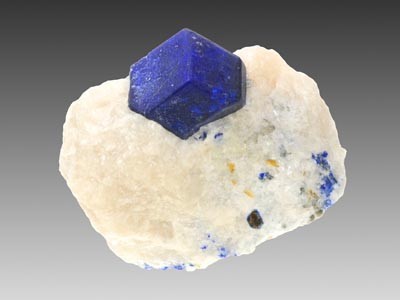
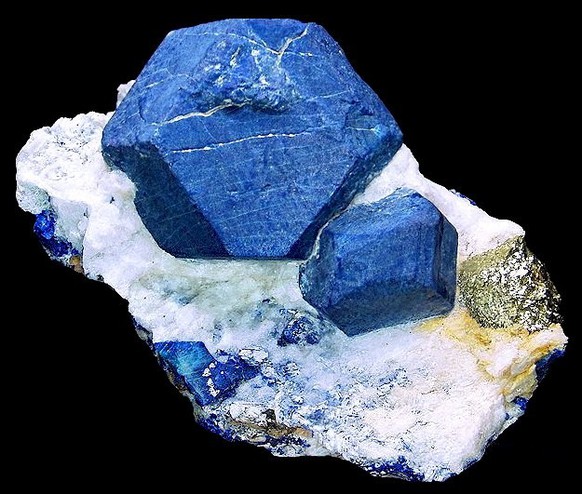
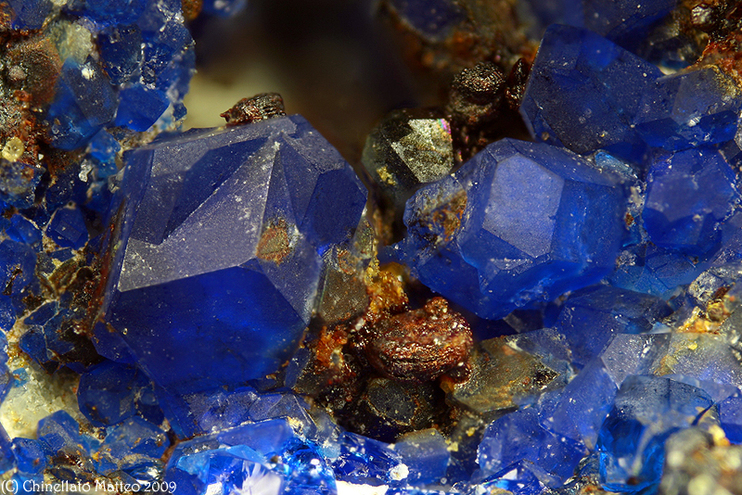
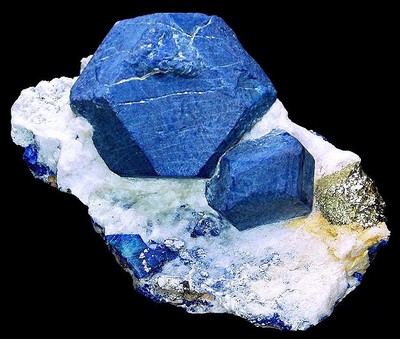
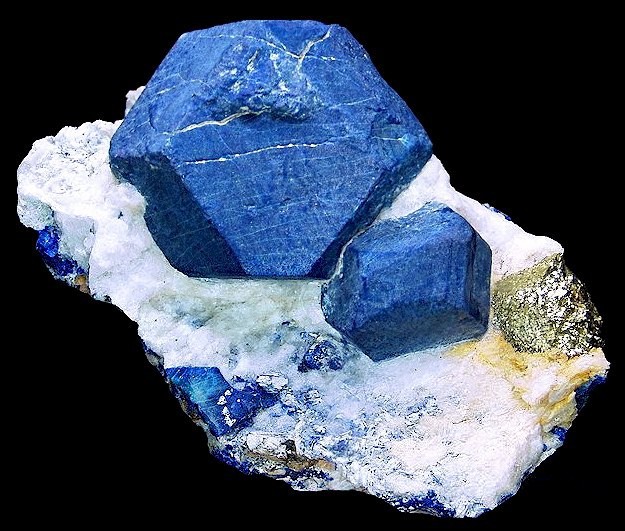
 symbol to view information about a locality.
The
symbol to view information about a locality.
The 





Ladjuar Medam, Sar-e-Sang, Kuran wa Munjan District, Badakhshan, Afghanistan